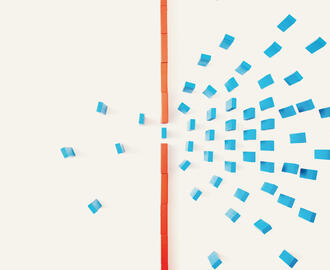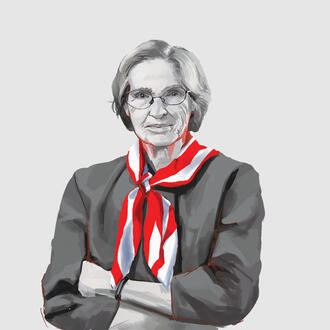Credit: Andrea Mongia
Ideas Made to Matter
Redesigning the link between worker well-being and company goals
By
Sherwin didn’t know he’d had a heart attack until his doctor told him the next day.
After 20 years working in information technology, Sherwin found himself at a Fortune 500 company in a software design role that required the divorced father of two to manage 5 a.m. wakeup calls and 70-hour workweeks. The last thing on his mind, he said in an interview with researchers, was exercising.
“I didn’t even realize it,” Sherwin said. “Just went into the doctor because I was not feeling well and they ran an EKG and they did some tests and said ‘You had a heart attack yesterday.’”
Sherwin’s work and home life were an example of overload, “the feeling of having too much to do in too little time,” MIT Sloan professor Erin Kelly and University of Minnesota sociology professor Phyllis Moen write in their new book “Overload: How Good Jobs Went Bad and What We Can Do About It.”
Over the course of about five years, Kelly and Moen and their collaborators in the Work, Family and Health Network studied how an organizational change initiative called STAR [Support. Transform. Achieve. Results.] benefited overloaded employees like Sherwin at a tech-focused company referred to as TOMO. They also looked at how those employee benefits affected TOMO’s bottom line. One result: A 40% lower turnover rate during a 3-year period, among the employees who went through STAR.
STAR is an example of a dual-agenda work redesign, an action plan that links employees’ well-being and experience with a company’s priorities and goals. A dual-agenda work redesign prompts employees and managers to look at how work can be changed in ways that benefit employees and their families, and also the organization, Kelly said.
“Work redesign is not a change in company policy, it is an effort to construct a new normal, to reconsider and revamp how a team does its work,” Kelly said. “Dual agenda refers to the fact that these changes address both organizational concerns — working effectively — and employee concerns — working in ways that are more sustainable and sane that reflect their personal and family priorities and protect their health.”
Soon after his heart attack, Sherwin was one of the TOMO employees assigned to the STAR initiative. Under the initiative, Sherwin was able to rearrange his schedule to a point where he could get his work done, spend time with family, and take care of himself.
He told the researchers what changed was the removal of “guilt” that came from working at home and coworkers and managers assuming if he wasn’t in the office from 8 a.m. to 5 p.m., “[he] must not be working.”
“The work that gets done here is what really should be judged, and how you get it done is really up to you,” Sherwin said.
Employees who went through the work redesign initiative showed a 40% lower turnover rate during a 3-year period.
Here’s what to keep in mind as you consider and pursue a dual-agenda work redesign:
Look for signs your company is in need of a dual-agenda work redesign
The primary warnings that a company is in need of a redesign are low employee retention and burnout or exhaustion. But Kelly said it can be difficult for these warnings to be noticed if employees try to power through and hide their overload. Management may miss the signs if they see the problem as exhausted working parents, rather than a systemic and broader issue.
“Often the pain is felt broadly and frontline workers and frontline managers know the current practices are problematic, but no one feels they have permission or time and space to do the thoughtful examination of what we can do differently,” Kelly said.
At TOMO, according to the study, 41% of the company’s IT professionals and 61% of their managers agreed or strongly agreed with the statement that there is “not enough time to get your job done.”
Remember a redesign is more than a wellness initiative or flex schedule
It’s not that Sherwin didn’t know how to take care of himself — like exercising regularly — it was that work responsibilities and expectations left him too exhausted to do anything about it.
“Work redesign begins to form the premise that what’s happening at work is affecting people’s health and well-being,” Kelly said.
Don’t confuse a dual-agenda work redesign with a wellness initiative or a flexible work policy. Yes, a redesign does promote employees’ well-being and health, but a wellness initiative is something like a stress management class at the office. And flexible work policies usually require an employee ask for permission to change their work schedule — like working from home a few days a week — rather than getting the work done whenever and however it fits their schedule.
“It’s a big shift from managers giving permission for a few people to deviate from an unexamined standard of doing things,” Kelly said.
Work redesign initiatives should involve employee reflection on current practices, and identifying changes that make sense from their perspective as well as the perspective of the company. Kelly said.
Get started
Begin with the assumption that employees should have as much say as possible in where, when, and how they do their work.
Get an in-house person or a consultant to guide the company through the redesign process. A good facilitator will get the questions of what’s being taken for granted out into the open and up for discussion.
“You have to figure out: How do we help people think beyond their current practice and let go of their assumptions of how things have to be, and do that in a way that doesn’t trigger too much defensiveness,” Kelly said. “It requires managers who are both open to stepping back and letting go of some of the ways they’ve managed in the past, sharing decisions with employees, and letting employees have more control or autonomy.”
And it requires employees who are brave enough to say something needs to change, Kelly said, whether it’s identifying that current practices are a problem for them personally, or highlighting that those practices are leading to poor quality of work, employee turnover and burnout, and a lack of creative solutions.
“Most work redesign initiatives will have an autonomy component,” Kelly said. “That’s not specific to STAR only, but reflects a broader approach to solving workplace problems by asking the employees who are most affected to take charge [and] exercise their discretion.”
Keep the benefits of a dual-agenda work redesign in mind
According to the research results, employees reduced their stress and psychological distress, improved their work-life balance, and increased job satisfaction.
And happier employees were more likely to be engaged, more enthusiastic about work, and more likely to stay at their jobs, she said.
“Of course when workers leave and they need to be replaced, they take some of their expertise and relationships, which is costly to the firm,” Kelly said. “In this case, studying experienced IT professionals, the costs of turnover were quite high.”



